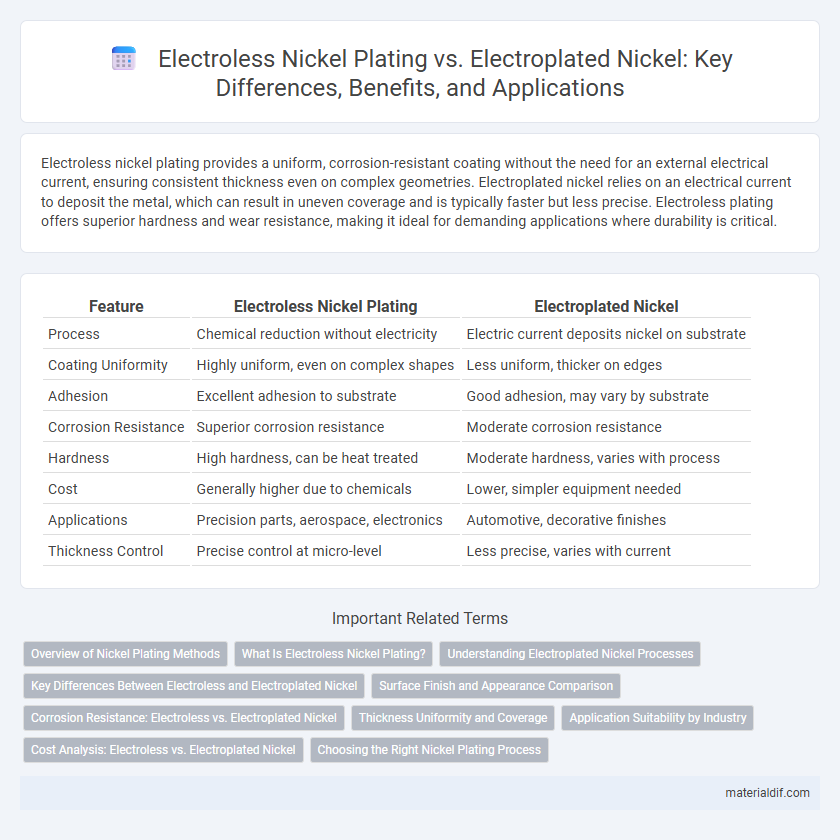Electroless nickel plating provides a uniform, corrosion-resistant coating without the need for an external electrical current, ensuring consistent thickness even on complex geometries. Electroplated nickel relies on an electrical current to deposit the metal, which can result in uneven coverage and is typically faster but less precise. Electroless plating offers superior hardness and wear resistance, making it ideal for demanding applications where durability is critical.
Table of Comparison
| Feature | Electroless Nickel Plating | Electroplated Nickel |
|---|---|---|
| Process | Chemical reduction without electricity | Electric current deposits nickel on substrate |
| Coating Uniformity | Highly uniform, even on complex shapes | Less uniform, thicker on edges |
| Adhesion | Excellent adhesion to substrate | Good adhesion, may vary by substrate |
| Corrosion Resistance | Superior corrosion resistance | Moderate corrosion resistance |
| Hardness | High hardness, can be heat treated | Moderate hardness, varies with process |
| Cost | Generally higher due to chemicals | Lower, simpler equipment needed |
| Applications | Precision parts, aerospace, electronics | Automotive, decorative finishes |
| Thickness Control | Precise control at micro-level | Less precise, varies with current |
Overview of Nickel Plating Methods
Electroless nickel plating uses a chemical reduction process to deposit a uniform nickel-phosphorus alloy coating without electrical current, ensuring even coverage on complex geometries and improving corrosion resistance. Electroplated nickel relies on electrolysis, where an electrical current drives nickel ions from a plating bath onto the substrate, offering precise thickness control but potential uneven deposits on intricate surfaces. Both methods enhance surface hardness and wear resistance, but electroless nickel plating is preferred for applications requiring consistent coating thickness and superior corrosion protection.
What Is Electroless Nickel Plating?
Electroless nickel plating is a chemical process that deposits a uniform layer of nickel-phosphorus or nickel-boron alloy onto a substrate without the use of an external electrical current. This autocatalytic reaction ensures even coating thickness on complex geometries and internal surfaces, improving corrosion resistance and wear protection. Unlike electroplated nickel, electroless nickel plating provides excellent adhesion and consistent metallurgical properties, making it ideal for aerospace, automotive, and electronics applications.
Understanding Electroplated Nickel Processes
Electroplated nickel involves depositing nickel onto a substrate using an external electrical current, allowing precise control over coating thickness and uniformity, making it ideal for applications requiring high corrosion resistance and wear durability. This process typically uses a nickel sulfamate or Watts bath, producing dense, adherent metal layers suited for automotive, aerospace, and electronics industries. Understanding parameters such as current density, bath composition, and temperature is crucial for optimizing electroplated nickel's mechanical and aesthetic properties.
Key Differences Between Electroless and Electroplated Nickel
Electroless nickel plating provides uniform coating thickness regardless of part geometry, while electroplated nickel relies on electrical current, causing uneven deposition on complex shapes. Electroless plating offers superior corrosion and wear resistance due to its consistent alloy composition, whereas electroplated nickel can vary in hardness and adhesion based on plating parameters. Electroless nickel requires chemical reduction for deposition, eliminating the need for an external power source, unlike electroplating which depends on electric current for metal ion reduction.
Surface Finish and Appearance Comparison
Electroless nickel plating delivers a uniform, smooth, and matte to semi-bright surface finish with superior corrosion resistance, ideal for intricate geometries and consistent appearance across complex parts. Electroplated nickel often results in a brighter, glossier finish but can exhibit uneven thickness and potential for nodules or roughness, especially on irregular surfaces. The electroless method ensures greater dimensional control and improved adhesion, making it preferred for critical applications requiring precise surface aesthetics and performance.
Corrosion Resistance: Electroless vs. Electroplated Nickel
Electroless nickel plating provides uniform thickness and superior corrosion resistance due to its autocatalytic chemical deposition process, which creates a dense, non-porous coating ideal for complex geometries. Electroplated nickel relies on an electric current that can lead to uneven thickness and potential weak points, making it less effective against corrosion in harsh environments. Studies show electroless nickel coatings exhibit enhanced resistance to oxidation and chemical attack compared to electroplated nickel, making them preferable for applications requiring long-term durability.
Thickness Uniformity and Coverage
Electroless nickel plating provides superior thickness uniformity and consistent coverage on complex geometries due to its autocatalytic chemical process, ensuring an even deposit regardless of part shape. Electroplated nickel, reliant on electrical current flow, often results in uneven thickness and limited coverage, especially on recessed or intricate areas, due to current density variations. The chemical deposition mechanism of electroless plating yields more reliable and uniform coatings for corrosion resistance and wear protection compared to electroplating methods.
Application Suitability by Industry
Electroless nickel plating offers uniform thickness and excellent corrosion resistance, making it ideal for aerospace, automotive, and electronics industries where precision and durability are critical. Electroplated nickel provides higher deposition rates and is cost-effective for large-scale applications in decorative coatings, plumbing fixtures, and electrical connectors. Both methods serve distinct industry needs, with electroless nickel favored for complex geometries and electroplating preferred for bulk manufacturing.
Cost Analysis: Electroless vs. Electroplated Nickel
Electroless nickel plating often incurs higher initial costs due to complex chemical baths and longer processing times, but it provides uniform coatings on intricate geometries, reducing rework expenses. Electroplated nickel typically offers lower upfront costs with faster deposition rates, making it more suitable for simple, high-volume parts. Cost analysis must consider factors such as bath maintenance, waste treatment, and the application's precision requirements to determine the most economical choice.
Choosing the Right Nickel Plating Process
Electroless nickel plating offers uniform coating thickness and superior corrosion resistance without requiring electrical current, making it ideal for complex geometries and internal surfaces. Electroplated nickel provides faster deposition rates and lower initial costs but may suffer from uneven coverage and less consistent corrosion protection. Selecting the appropriate nickel plating process depends on part complexity, desired coating properties, and budget constraints to optimize performance and durability.
Electroless nickel plating vs Electroplated nickel Infographic

 materialdif.com
materialdif.com